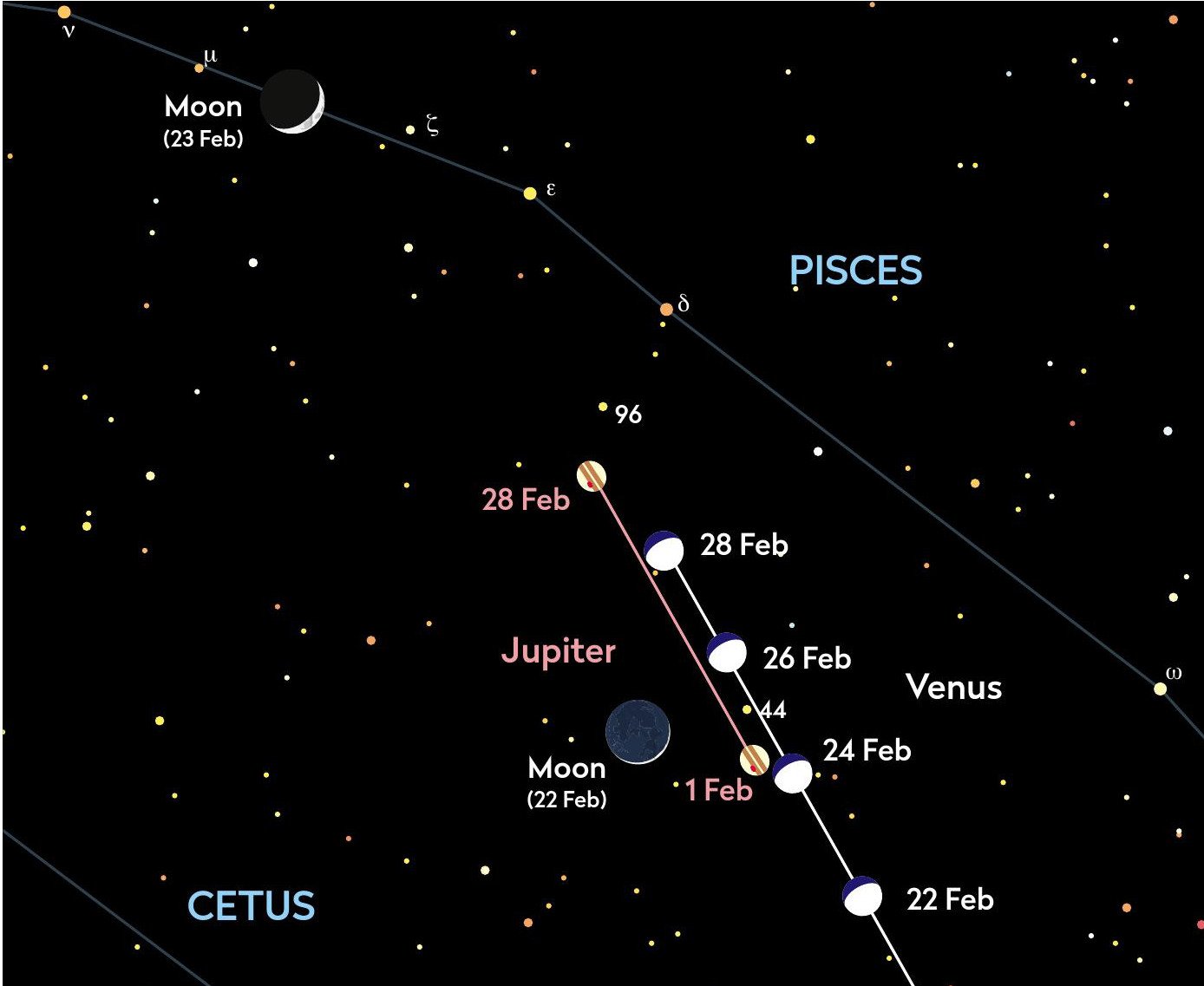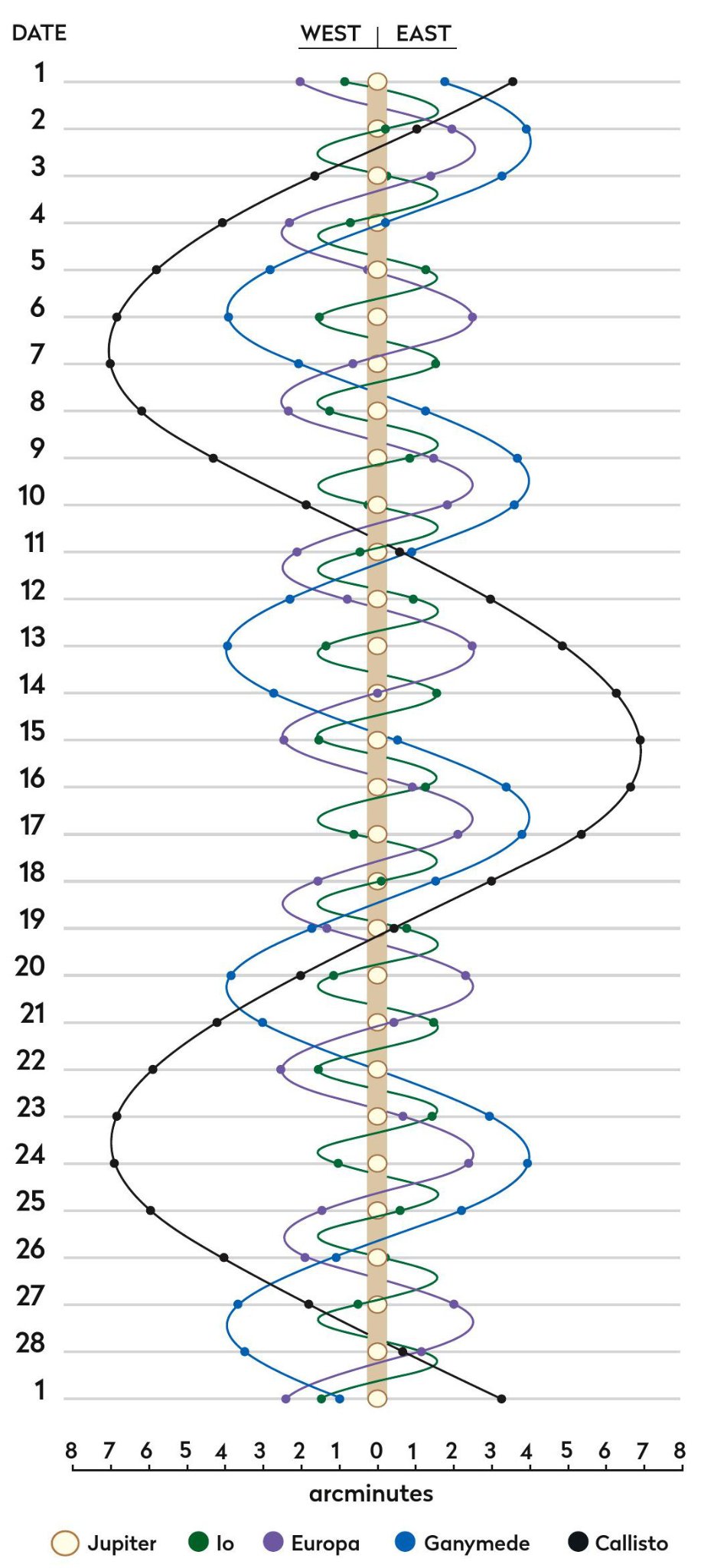Our celestial neighbourhood in February
PICK OF THE MONTH
Jupiter
Best time to see: 1 February, from 17:30 UT
Altitude: 34°
Location: Pisces
Direction: South-southwest
Features: Complex atmosphere, Galilean moons
Recommended equipment: 75mm or larger

Jupiter is rapidly losing ground to the evening twilight, appearing 29° above the southwest horizon under deep twilight conditions at the start of the month, but reaching only 12° above the western horizon by the time we reach the end of the month.
Through the eyepiece of a telescope, Jupiter’s low altitude will mean it will be badly affected by seeing. This causes fine detail to wobble and blur, making such detail difficult to see well. On a more encouraging note, Jupiter’s declination is increasing and when next at opposition in early November, it will be able to reach an altitude of 50° in a dark sky.
A small telescope will currently show the planet’s disc, two main belts and, for apertures above 100mm, the persistent atmospheric feature known as the Great Red Spot. The four Galilean moons are another amazing sight to watch as their starlike dots appear to dance endlessly around the planet.
As the end of February approaches and we move into the start of March, mag. –1.9 Jupiter will appear really close to mag. –3.9 Venus, the two planets forming an impressive pair above the western horizon even despite their low altitude. On 28 February, they will appear 1.5° apart, a prelude to their closest separation of just 0.6° on 1 March. If you have several clear evenings, watching a planetary conjunction involving two bright planets is fascinating. The rapid positional shifts really give you a sense of the threedimensional nature of our Solar System.
On the evening of 22 February, a thin 8%-lit waxing crescent Moon sits south of the imaginary line joining Venus to Jupiter, a particularly striking display and a great scene to photograph if the conditions are clear.
Mercury
Best time to see: 1 February, 40 minutes before sunrise
Altitude: 3.3° (very low)
Location: Sagittarius
Direction: Southeast
Having reached greatest western elongation on 30 January, Mercury is a low morning object this month. Its altitude before sunrise is dropping and despite being around mag. 0.0 for the first half of February, brightening to –0.5 by the end of the month, Mercury is unlikely to be seen.
Venus
Best time to see: 28 February, 1 hour after sunset
Altitude: 16°
Location: Pisces
Direction: West-southwest
Evening object setting two hours and 15 minutes after sunset at the start of February. Shining at mag. –3.8 on 1 February, if the sky is clear after sunset, it’ll be hard to miss. Very close to Neptune on the evenings of 14 and 15 February. From the UK, the separation on 14 February is 50.2 arcminutes, reducing to 21.8 arcminutes on the 15th. On the evening of 22 February, mag. –3.9 Venus sits 7.5° from mag. –2.0 Jupiter, a slender 8%-lit waxing crescent Moon also joining the party. By the end of the month, its separation from Jupiter reduces to 1.5°.
Mars
Best time to see: 1 February, 20:00 UT
Altitude: 62°
Location: Taurus
Direction: South
Mars is moving away from Earth and consequently is dimming and shrinking through the eyepiece. On 1 February, mag. –0.2 Mars appears 10 arcseconds across. By 28 February, its magnitude drops to +0.4 and its apparent diameter to 8 arcseconds. It remains in Taurus all month.
Saturn
Not visible this month
Saturn is in conjunction with the Sun on 16 February and is not visible this month.
Uranus
Best time to see: 1 February, from 17:30 UT
Altitude: 52°
Location: Aries
Direction: Just west of south
An evening planet, no longer visible at its highest position under astronomically dark skies. On 1 February, true darkness sees Uranus at an altitude of 52°, only a fraction below its best, but by the end of the month, its altitude will have dropped to 38° before this condition is met. Uranus shines around mag. +5.8 and requires binoculars to see convincingly. The southern limb of the Moon is around 4 arcminutes from Uranus under daylight conditions at 11:45 UT on 25 February.
Neptune
Best time to see: 1 February, from 18:50 UT
Altitude: 16°
Location: Aquarius
Direction: West-southwest
The observing window closes on Neptune this month, the dim planet being just 16° up as true darkness falls at the start of February, but unable to be seen against dark skies from 22 February onwards. As Venus rushes towards its close encounter with Jupiter at the end of the month, it will also make a harder-to-see close pass of Neptune, visible on the evenings of 14 and 15 February.
More ONLINE
Print out observing forms for recording planetary events
www.skyatnightmagazine.com/bonus-content/RRX0AL4
The planets in February
The phase and relative sizes of the planets this month. Each planet is shown with south at the top, to show its orientation through a telescope

Jupiter’s moons: February
Using a small scope you can spot Jupiter’s biggest moons. Their positions change dramatically over the month, as shown on the diagram. The line by each date represents 00:00 UT.
